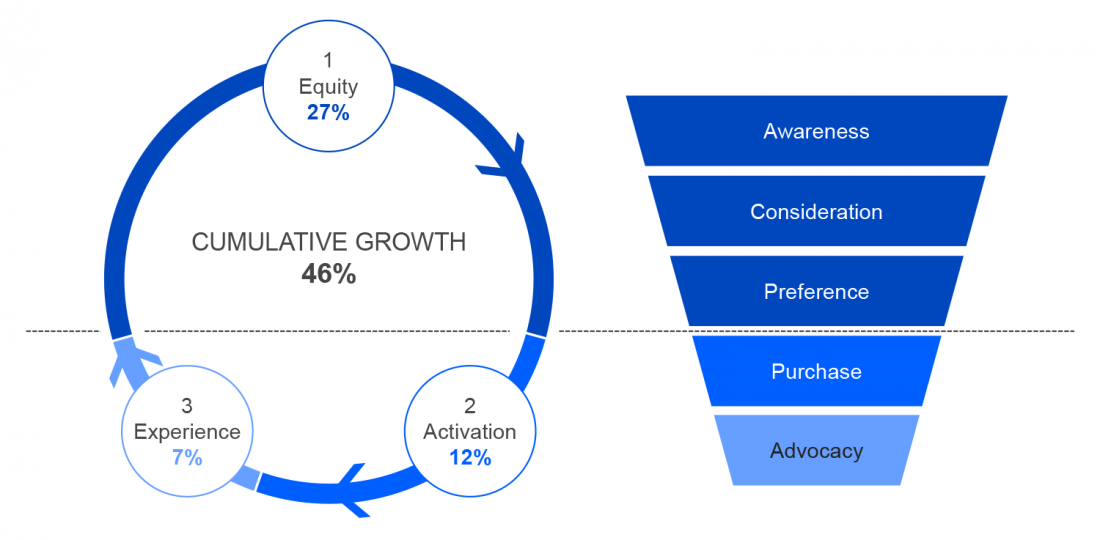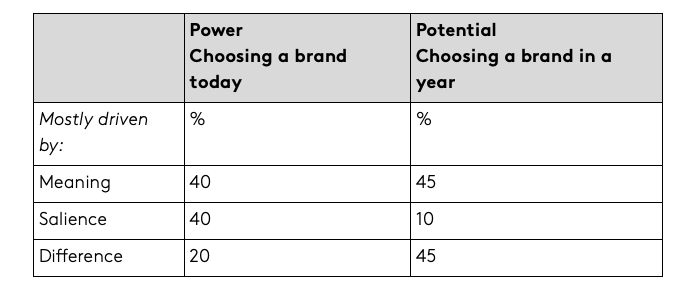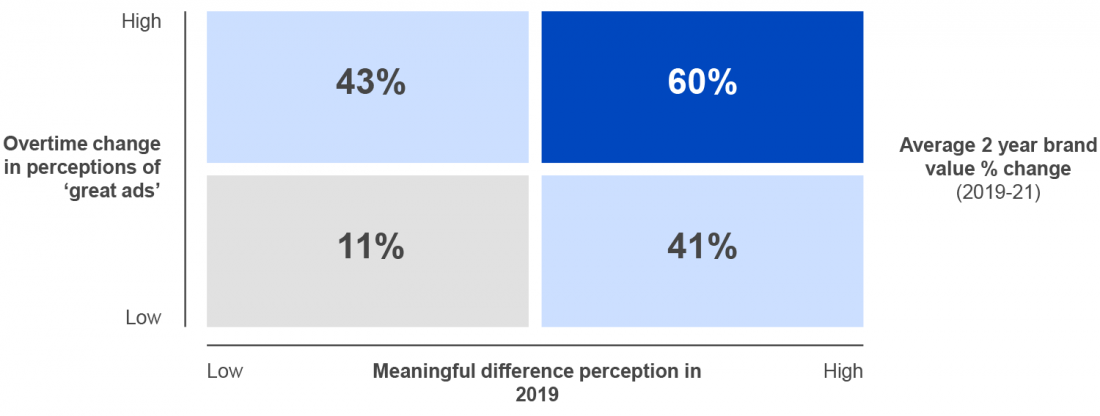Modern Marketing Dilemmas: What Role Does Brand Play In The Consumer Decision Journey?
By: Mary Kyriakidi, Global Thought Leader at Kantar


The influence exerted on future buyers during the Equity phase is much greater than simply widening the mouth of the funnel (top) as in due time, its neck (bottom) will widen too.
‘Easy to choose’: Why accreting brand value trumps a brand image boost
When iPad launched in 2010, 45% of consumers couldn’t name any other new products that year. What sits behind Apple’s mammoth recognition endeavour was not simply an unescapable campaign, rather the greatest brand value case study in the history of marketing. The brand’s clear positioning around the three core tenets of simplicity, creativity and humanity and their concerted execution in everything they did make Apple one of the most striking turnaround stories of the last two decades.
Apple’s story has been celebrated in Kantar BrandZ rankings over the last 15 years. In the 2021 report – for the first time ever – Apple exceeded a half trillion US dollars in brand value. But the knack of building brand value is not restricted to the biggest, era-defining brands (like Apple and Amazon). Five much smaller brands: Nvidia, Texas Instruments, Qualcomm, AMD, and Tata Consultancy Services -all from the business solutions and technology provider category – succeeded in turbo-charging their brand value and proudly featured in the Kantar BrandZ 2021 Global report.
So, what is brand value and how can you grow it?
A brand’s value is compatible with its brand equity, the power in the mind of the consumer that is revealed in their choices. No longer an enigmatic concept, brand equity can be tangibly measured with our validated Brand Power and Potential metrics, our surrogate metrics for understanding and predicting sales. With these measures we can detect if a brand is moving the needle in being perceived as:
- Meaningful: is it meeting people’s needs?
- Different: is it perceived as a trend setter for its category?
- Salient: a brand that comes to mind quickly in a purchase situation?
Not all levers contribute equally to sales though, and there is a distinction between the present and the future. Here’s the typical make-up of brand growth in the short and the long-term. But of course, this can vary across categories and market situations.

Our analysis reveals that a salient brand, one that comes to mind easily (NB: this is not awareness) is more likely to be chosen presently. But, to generate sales in a year’s time, salience alone doesn’t suffice. Brands with ‘excess Meaningful Difference’ over Salience are those more likely to grow and be profitable in the future. Here are three striking examples from Kantar BrandZ that recently bolstered their brand equity through meaningful difference.
TikTok experienced astonishing growth in recent years by offering something genuinely different to the world of social media. It’s the simple fact that everyone can become a content creator…at the click of a button.
Puma hasn’t just grown empty salience but strengthened its consumer relationships by building meaningful difference. And although Puma lacks the size of other global sports giants, it has enjoyed a significant brand value growth rate.
Haitian’s culinary range has shown strong brand equity in China. Having built a superior relationship with consumers through corporate responsibility, Haitian continues to demonstrate high Meaningful Difference ahead of Salience. A positive gap that signals real potential to grow further.
Brands that are on a mission to strengthen their brand value invest in brand marketing and brand advertising. If effective, surges in long-term sales revenue, margins, and profit follow.
What does this mean for marketing execution?
Each year, we test over 13,000 ads using Link to identify the crème de la crème of ads around the world – as judged by the consumers. Ads that hit the mark both in terms of generating short-term sales and building equity. In 2021 we revealed the five habits of highly effective advertisers five common denominators of the best performers that can act as guidelines for advertisers. (This year we reveal the winning ads from 2021 on 26 April – and show what ignites their success.)
And guess what? Being Meaningfully Different was one of the five habits. We found that that to spur market share and to shield a price premium, an ad should create impressions that frame a brand in meaningful and different ways in people’s memories. Going beyond addressing the consumer’s functional needs with the standard approach to product and benefits, these ads strike a chord with emotional and social needs in the category leaving viewers with a lingering thought. Here’s the evidence:
The effect of strong communications is ever greater for a brand a with meaningfully different proposition

Because “people will forget what you said, people will forget what you did, but people will never forget how you made them feel”, as Maya Angelou may or may not have said.
This Bosch ad that consumers rated as one of the best in the Kantar Creative Effectiveness Awards 2021, brings meaningfully difference to life. Using the art of storytelling, the ad presents a considerate gesture of a loving son who is about to leave home for the first time. To soothe his mother’s sadness, he uses Atino Laser and creates a gallery of their family memories on the wall, leaving on display the message: ‘Bis Balt!’ meaning ‘bye for now’.
Although meaningfully different creative is a good way to stand out and boost effectiveness, it doesn’t solve the day-to-day more tactical marketing conundrums. We will unravel these in a future article.
Keep calm and believe in science
It seems to me that Peter Markey, Chief Marketing Officer at Boots UK, is right: the modern CMO is “part artist, part scientist, part champion for marketing with a business” perpetually striving to strike a balance between gut instinct and data-led decision making. At the top of her balancing act, the marketer/juggler is adding value and driving profitable share growth.
The stages of the consumer’s decision journey are a great tool to help marketers divide their efforts and ease the tension between equity and activation, between mental and physical availability. Influencing future buyers (those not currently primed to buy their brand) and their future decision-making contributes the lion’s share to cumulative growth. Strategically it’s the right thing to do as future customers align with future cash flows and business prosperity but selfishly it’s how they will do right by themselves as they (marketers) have a monopoly at the top of the funnel; up there, no one else can steal their thunder.
Science can help. Those in possession of great data (like Kantar) are on a mission to help marketers foster their brands whilst in parallel giving them ammunition for their short-term strategies. Please get in touch to discuss mental, physical availability and the mechanics of ‘easy to choose’. And follow this series for the full spectrum of marketing dilemmas about how brands create values for their businesses.
This has been originally published on Kantar





